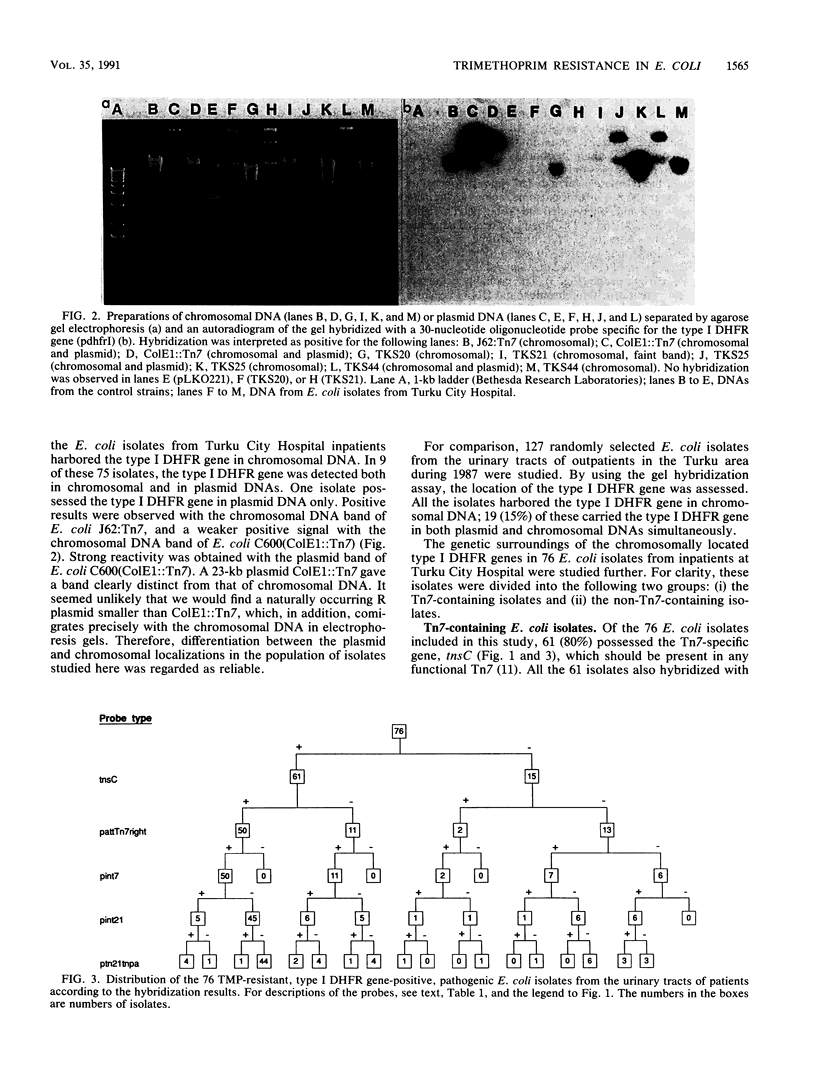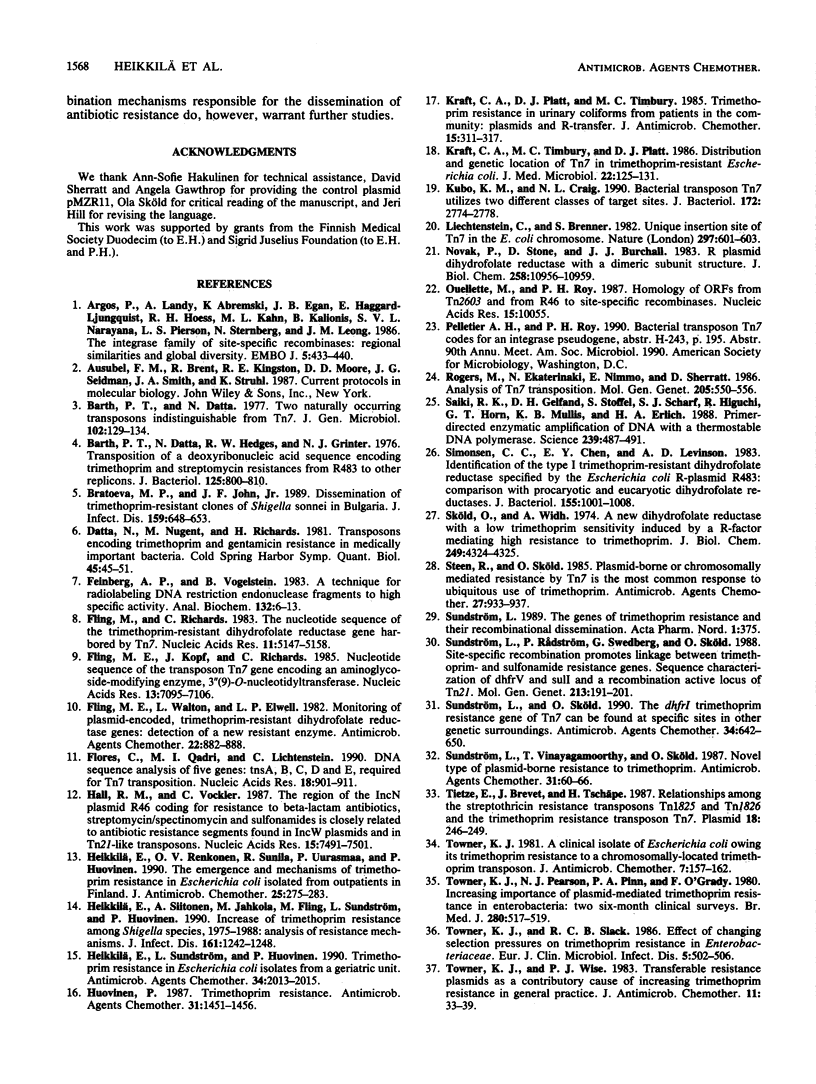Abstract
Among a collection of clinical Escherichia coli isolates, the type I dihydrofolate reductase (DHFR) mediating trimethoprim resistance was generally observed to be chromosomally determined. Only a minority of isolates carried the type I DHFR gene simultaneously on a plasmid. The majority of E. coli isolates studied also hybridized with a probe specific for the transposition gene tnsC of transposon Tn7; and in most of these isolates, Tn7 was found to be inserted into a preferred site in the E. coli chromosome. A minority of isolates that harbored the type I DHFR gene in the chromosome lacked a complete Tn7. Some of these harbored the type I DHFR gene inserted in a structure similar to that containing the gene for streptomycin resistance in Tn21. In the other isolates that were negative for a complete Tn7, the sequences upstream of the type I DHFR gene were demonstrated to be homologous to those flanking the type I DHFR gene in Tn7. This could indicate that the antibiotic resistance region of Tn7 may occur independently of this transposon. In two isolates, no sequences resembling Tn7 or Tn21 were found adjacent to the type I DHFR gene.
Full text
PDF







Images in this article
Selected References
These references are in PubMed. This may not be the complete list of references from this article.
- Argos P., Landy A., Abremski K., Egan J. B., Haggard-Ljungquist E., Hoess R. H., Kahn M. L., Kalionis B., Narayana S. V., Pierson L. S., 3rd The integrase family of site-specific recombinases: regional similarities and global diversity. EMBO J. 1986 Feb;5(2):433–440. doi: 10.1002/j.1460-2075.1986.tb04229.x. [DOI] [PMC free article] [PubMed] [Google Scholar]
- Barth P. T., Datta N., Hedges R. W., Grinter N. J. Transposition of a deoxyribonucleic acid sequence encoding trimethoprim and streptomycin resistances from R483 to other replicons. J Bacteriol. 1976 Mar;125(3):800–810. doi: 10.1128/jb.125.3.800-810.1976. [DOI] [PMC free article] [PubMed] [Google Scholar]
- Barth P. T., Datta N. Two naturally occurring transposons indistinguishable from Tn7. J Gen Microbiol. 1977 Sep;102(1):129–134. doi: 10.1099/00221287-102-1-129. [DOI] [PubMed] [Google Scholar]
- Bratoeva M. P., John J. F., Jr Dissemination of trimethoprim-resistant clones of Shigella sonnei in Bulgaria. J Infect Dis. 1989 Apr;159(4):648–653. doi: 10.1093/infdis/159.4.648. [DOI] [PubMed] [Google Scholar]
- Datta N., Nugent M., Richards H. Transposons encoding trimethoprim or gentamicin resistance in medically important bacteria. Cold Spring Harb Symp Quant Biol. 1981;45(Pt 1):45–51. doi: 10.1101/sqb.1981.045.01.009. [DOI] [PubMed] [Google Scholar]
- Feinberg A. P., Vogelstein B. A technique for radiolabeling DNA restriction endonuclease fragments to high specific activity. Anal Biochem. 1983 Jul 1;132(1):6–13. doi: 10.1016/0003-2697(83)90418-9. [DOI] [PubMed] [Google Scholar]
- Fling M. E., Kopf J., Richards C. Nucleotide sequence of the transposon Tn7 gene encoding an aminoglycoside-modifying enzyme, 3"(9)-O-nucleotidyltransferase. Nucleic Acids Res. 1985 Oct 11;13(19):7095–7106. doi: 10.1093/nar/13.19.7095. [DOI] [PMC free article] [PubMed] [Google Scholar]
- Fling M. E., Richards C. The nucleotide sequence of the trimethoprim-resistant dihydrofolate reductase gene harbored by Tn7. Nucleic Acids Res. 1983 Aug 11;11(15):5147–5158. doi: 10.1093/nar/11.15.5147. [DOI] [PMC free article] [PubMed] [Google Scholar]
- Fling M. E., Walton L., Elwell L. P. Monitoring of plasmid-encoded, trimethoprim-resistant dihydrofolate reductase genes: detection of a new resistant enzyme. Antimicrob Agents Chemother. 1982 Nov;22(5):882–888. doi: 10.1128/aac.22.5.882. [DOI] [PMC free article] [PubMed] [Google Scholar]
- Flores C., Qadri M. I., Lichtenstein C. DNA sequence analysis of five genes; tnsA, B, C, D and E, required for Tn7 transposition. Nucleic Acids Res. 1990 Feb 25;18(4):901–911. doi: 10.1093/nar/18.4.901. [DOI] [PMC free article] [PubMed] [Google Scholar]
- Hall R. M., Vockler C. The region of the IncN plasmid R46 coding for resistance to beta-lactam antibiotics, streptomycin/spectinomycin and sulphonamides is closely related to antibiotic resistance segments found in IncW plasmids and in Tn21-like transposons. Nucleic Acids Res. 1987 Sep 25;15(18):7491–7501. doi: 10.1093/nar/15.18.7491. [DOI] [PMC free article] [PubMed] [Google Scholar]
- Heikkilä E., Renkonen O. V., Sunila R., Uurasmaa P., Huovinen P. The emergence and mechanisms of trimethoprim resistance in Escherichia coli isolated from outpatients in Finland. J Antimicrob Chemother. 1990 Feb;25(2):275–283. doi: 10.1093/jac/25.2.275. [DOI] [PubMed] [Google Scholar]
- Heikkilä E., Siitonen A., Jahkola M., Fling M., Sundström L., Huovinen P. Increase of trimethoprim resistance among Shigella species, 1975-1988: analysis of resistance mechanisms. J Infect Dis. 1990 Jun;161(6):1242–1248. doi: 10.1093/infdis/161.6.1242. [DOI] [PubMed] [Google Scholar]
- Heikkilä E., Sundström L., Huovinen P. Trimethoprim resistance in Escherichia coli isolates from a geriatric unit. Antimicrob Agents Chemother. 1990 Oct;34(10):2013–2015. doi: 10.1128/aac.34.10.2013. [DOI] [PMC free article] [PubMed] [Google Scholar]
- Huovinen P. Trimethoprim resistance. Antimicrob Agents Chemother. 1987 Oct;31(10):1451–1456. doi: 10.1128/aac.31.10.1451. [DOI] [PMC free article] [PubMed] [Google Scholar]
- Kraft C. A., Platt D. J., Timbury M. C. Trimethoprim resistance in urinary coliforms from patients in the community: plasmids and R-transfer. J Antimicrob Chemother. 1985 Mar;15(3):311–317. doi: 10.1093/jac/15.3.311. [DOI] [PubMed] [Google Scholar]
- Kraft C. A., Timbury M. C., Platt D. J. Distribution and genetic location of Tn7 in trimethoprim-resistant Escherichia coli. J Med Microbiol. 1986 Sep;22(2):125–131. doi: 10.1099/00222615-22-2-125. [DOI] [PubMed] [Google Scholar]
- Kubo K. M., Craig N. L. Bacterial transposon Tn7 utilizes two different classes of target sites. J Bacteriol. 1990 May;172(5):2774–2778. doi: 10.1128/jb.172.5.2774-2778.1990. [DOI] [PMC free article] [PubMed] [Google Scholar]
- Lichtenstein C., Brenner S. Unique insertion site of Tn7 in the E. coli chromosome. Nature. 1982 Jun 17;297(5867):601–603. doi: 10.1038/297601a0. [DOI] [PubMed] [Google Scholar]
- Novak P., Stone D., Burchall J. J. R plasmid dihydrofolate reductase with a dimeric subunit structure. J Biol Chem. 1983 Sep 25;258(18):10956–10959. [PubMed] [Google Scholar]
- Ouellette M., Roy P. H. Homology of ORFs from Tn2603 and from R46 to site-specific recombinases. Nucleic Acids Res. 1987 Dec 10;15(23):10055–10055. doi: 10.1093/nar/15.23.10055. [DOI] [PMC free article] [PubMed] [Google Scholar]
- Rogers M., Ekaterinaki N., Nimmo E., Sherratt D. Analysis of Tn7 transposition. Mol Gen Genet. 1986 Dec;205(3):550–556. doi: 10.1007/BF00338097. [DOI] [PubMed] [Google Scholar]
- Saiki R. K., Gelfand D. H., Stoffel S., Scharf S. J., Higuchi R., Horn G. T., Mullis K. B., Erlich H. A. Primer-directed enzymatic amplification of DNA with a thermostable DNA polymerase. Science. 1988 Jan 29;239(4839):487–491. doi: 10.1126/science.2448875. [DOI] [PubMed] [Google Scholar]
- Simonsen C. C., Chen E. Y., Levinson A. D. Identification of the type I trimethoprim-resistant dihydrofolate reductase specified by the Escherichia coli R-plasmid R483: comparison with procaryotic and eucaryotic dihydrofolate reductases. J Bacteriol. 1983 Sep;155(3):1001–1008. doi: 10.1128/jb.155.3.1001-1008.1983. [DOI] [PMC free article] [PubMed] [Google Scholar]
- Sköld O., Widh A. A new dihydrofolate reductase with low trimethoprim sensitivity induced by an R factor mediating high resistance to trimethoprim. J Biol Chem. 1974 Jul 10;249(13):4324–4325. [PubMed] [Google Scholar]
- Steen R., Sköld O. Plasmid-borne or chromosomally mediated resistance by Tn7 is the most common response to ubiquitous use of trimethoprim. Antimicrob Agents Chemother. 1985 Jun;27(6):933–937. doi: 10.1128/aac.27.6.933. [DOI] [PMC free article] [PubMed] [Google Scholar]
- Sundström L., Rådström P., Swedberg G., Sköld O. Site-specific recombination promotes linkage between trimethoprim- and sulfonamide resistance genes. Sequence characterization of dhfrV and sulI and a recombination active locus of Tn21. Mol Gen Genet. 1988 Aug;213(2-3):191–201. doi: 10.1007/BF00339581. [DOI] [PubMed] [Google Scholar]
- Sundström L., Vinayagamoorthy T., Sköld O. Novel type of plasmid-borne resistance to trimethoprim. Antimicrob Agents Chemother. 1987 Jan;31(1):60–66. doi: 10.1128/aac.31.1.60. [DOI] [PMC free article] [PubMed] [Google Scholar]
- Tietze E., Brevet J., Tschäpe H. Relationships among the streptothricin resistance transposons Tn1825 and Tn1826 and the trimethoprim resistance transposon Tn7. Plasmid. 1987 Nov;18(3):246–249. doi: 10.1016/0147-619x(87)90067-9. [DOI] [PubMed] [Google Scholar]
- Towner K. J. A clinical isolate of Escherichia coli owing its trimethoprim resistance to a chromosomally-located trimethoprim transposon. J Antimicrob Chemother. 1981 Feb;7(2):157–162. doi: 10.1093/jac/7.2.157. [DOI] [PubMed] [Google Scholar]
- Towner K. J., Pearson N. J., Pinn P. A., O'Grady F. Increasing importance of plasmid-mediated trimethoprim resistance in enterobacteria: two six-month clinical surveys. Br Med J. 1980 Feb 23;280(6213):517–519. doi: 10.1136/bmj.280.6213.517. [DOI] [PMC free article] [PubMed] [Google Scholar]
- Towner K. J., Slack R. C. Effect of changing selection pressures on trimethoprim resistance in Enterobacteriaceae. Eur J Clin Microbiol. 1986 Oct;5(5):502–506. doi: 10.1007/BF02017691. [DOI] [PubMed] [Google Scholar]
- Towner K. J., Wise P. J. Transferable resistance plasmids as a contributory cause of increasing trimethoprim resistance in general practice. J Antimicrob Chemother. 1983 Jan;11(1):33–39. doi: 10.1093/jac/11.1.33. [DOI] [PubMed] [Google Scholar]
- Waddell C. S., Craig N. L. Tn7 transposition: recognition of the attTn7 target sequence. Proc Natl Acad Sci U S A. 1989 Jun;86(11):3958–3962. doi: 10.1073/pnas.86.11.3958. [DOI] [PMC free article] [PubMed] [Google Scholar]
- Ward E., Grinsted J. The nucleotide sequence of the tnpA gene of Tn21. Nucleic Acids Res. 1987 Feb 25;15(4):1799–1806. doi: 10.1093/nar/15.4.1799. [DOI] [PMC free article] [PubMed] [Google Scholar]
- Wiedemann B., Meyer J. F., Zühlsdorf M. T. Insertions of resistance genes into Tn21-like transposons. J Antimicrob Chemother. 1986 Oct;18 (Suppl 100):85–92. doi: 10.1093/jac/18.supplement_c.85. [DOI] [PubMed] [Google Scholar]
- Womble D. D., Rownd R. H. Genetic and physical map of plasmid NR1: comparison with other IncFII antibiotic resistance plasmids. Microbiol Rev. 1988 Dec;52(4):433–451. doi: 10.1128/mr.52.4.433-451.1988. [DOI] [PMC free article] [PubMed] [Google Scholar]
- Young H. K., Jesudason M. V., Koshi G., Amyes S. G. Trimethoprim resistance amongst urinary pathogens in south India. J Antimicrob Chemother. 1986 May;17(5):615–621. doi: 10.1093/jac/17.5.615. [DOI] [PubMed] [Google Scholar]



